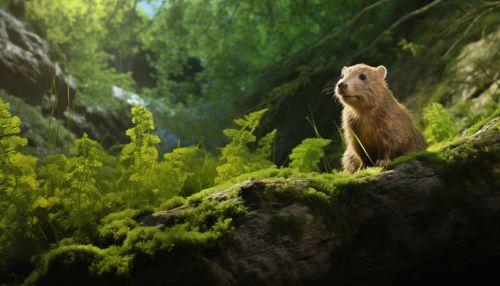Evolution of mammals
Origins of Mammals
Mammals are a group of vertebrates constituting the class Mammalia, characterized by the presence of mammary glands which in females produce milk for feeding (nursing) their young, a neocortex (a region of the brain), fur or hair, and three middle ear bones. These characteristics distinguish them from reptiles and birds, from which they diverged in the Carboniferous period over 300 million years ago.


The earliest mammals were small, nocturnal, and insectivorous, characteristics that provided them with the means to survive in a world dominated by larger and more aggressive reptiles. The evolution of mammals has passed through many stages since the first appearance of their synapsid ancestors in the late Carboniferous period.
Synapsid Ancestors
The first mammalian traits emerged in the synapsids, a group of amniotes that includes mammals and their extinct relatives. Synapsids are characterized by a single hole, known as the temporal fenestra, in the skull behind each eye. This feature distinguishes them from the diapsids (reptiles and birds), which have two temporal fenestrae, and the anapsids, which have none.
Therapsids and Cynodonts
The synapsids gave rise to the therapsids in the early Permian period, around 275 million years ago. Therapsids, often referred to as "mammal-like reptiles", show a number of physical traits that foreshadow those of mammals, such as differentiated teeth and the beginnings of a secondary palate.
The therapsids evolved into the cynodonts in the late Permian period. Cynodonts are the most mammal-like of the non-mammalian synapsids; their name, meaning "dog teeth", refers to their differentiated teeth, a characteristic of mammals. Cynodonts also had a secondary palate, which allowed them to chew and breathe at the same time, a trait shared by all mammals.
Mammaliaformes and the First True Mammals
The first true mammals appeared in the late Triassic period, around 225 million years ago. These early mammals, known as mammaliaformes, were small, nocturnal, and insectivorous. They had fur, a trait which provided insulation and allowed them to be active at night when temperatures were cooler.
The mammaliaformes gave rise to the first true mammals, which are distinguished by a number of key traits, including a jaw joint formed by the dentary and squamosal bones, three middle ear bones, and mammary glands.
Evolution of Modern Mammal Groups
The three main groups of modern mammals – monotremes, marsupials, and placentals – diverged from a common ancestor in the early Jurassic period, around 180 million years ago. Monotremes, such as the platypus and echidna, lay eggs, while marsupials and placentals give birth to live young.
Marsupials, such as kangaroos and possums, give birth to relatively undeveloped young that continue to develop outside the womb, typically in a pouch. Placentals, which include humans, dogs, and whales, give birth to more fully developed young.
Mammalian Diversification
The diversification of mammals accelerated in the Cretaceous period, around 145 to 66 million years ago. This period saw the emergence of the first bats, rodents, and primates, among other groups.
The extinction of the dinosaurs at the end of the Cretaceous period, likely caused by a meteor impact, allowed mammals to expand into ecological niches previously occupied by dinosaurs. This led to a rapid diversification of mammals in the early Cenozoic era, known as the "Age of Mammals".
Conclusion
The evolution of mammals has been a long and complex process, marked by numerous adaptations and diversifications. From their origins in the synapsids of the Carboniferous period, mammals have evolved into a diverse group of animals that inhabit a wide range of environments and exhibit a remarkable range of behaviors and adaptations.
